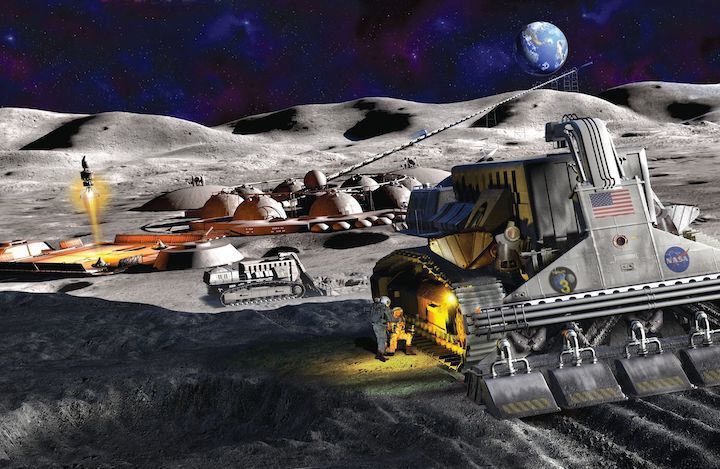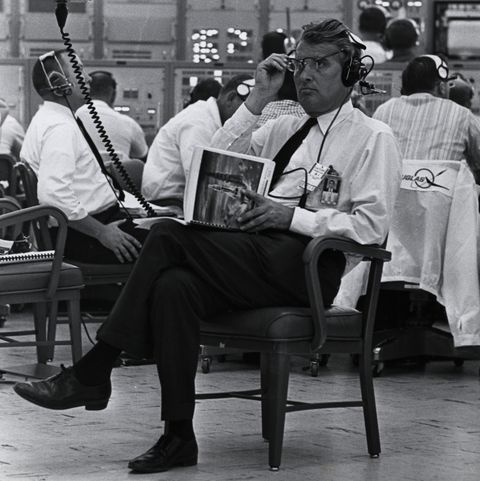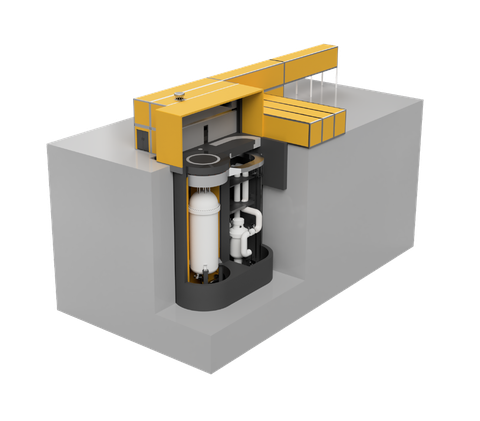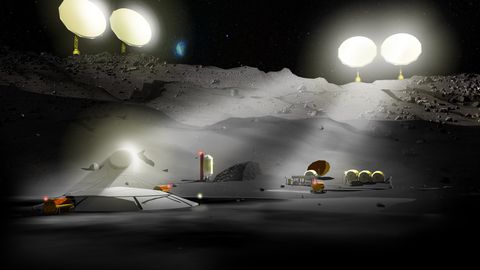Physicist Gerard K. O’Neill on The Tonight Show with Johnny Carson
“We've never done a study or taken a survey, to my knowledge, but my sense is that NASA is very heavily weighted towards the von Braunian perspective,” says Philip Metzger, a 30-year NASA veteran and planetary physicist at the University of Central Florida. “NASA has this vision of exploring Mars and wanting to put the first humans on Mars. It will be a brilliant triumph, and so NASA wants to lead the way...There's a very strong camp at NASA that sees the moon as a distraction.”
The battle between these camps will play out as NASA pushes deeper into the solar system. What moon mining enthusiasts fear the most is a repeat of what followed the 1970s moonshots.
“If we can support Earth's economy with off-planet industry, then we can create the economic environment where Mars missions become affordable,” says Metzger, an avowed O’Neillian. “We argue that if we go too fast and if we skip the buildup of industry in cislunar space, then the Mars missions are going to end up with another Apollo-era withdrawal.”
WHAT’S FOR SALE?

An illustration of lunar mining from the October 2004 cover of Popular Mechanics.
Even among O’Neillians who agree that the moon’s resources should be tapped, there is no consensus on how to do it. Even the most basic question—what should be extracted and sold—has changed over time.
The moon has many attractive commodities, including metals for construction, silicon for solar panels, and Helium-3 that could be used in hypothetical fusion reactors. The prevailing idea was to mine things that are common on the moon but rare on Earth, and bring it back planetside to sell for a tidy sum.
Over time, the question became: What if the money could be made selling commodities for use in space instead of bringing them to market down the gravity well? The commodity of choice for this kind of mining was oxygen.
“The moon is 42 percent oxygen by mass and the biggest cost of spaceflight is launching oxygen,” says Metzger.
The idea was to extract oxygen for use as fuel and in life support systems but import any needed hydrogen from Earth. (NASA is still looking at this possibility.) This kind of mining can be done anywhere on the moon by scraping the O2-infused regolith. But now there is a strong case to utilize the moon’s trove of hydrogen, and that means chasing large concentrations of lunar ice collected in craters.
“The ice angle is the biggest thing that's changed since the post-Apollo days. And it's fairly recent,” says Sowers. “You can split water into hydrogen and oxygen, the most efficient chemical propellants known. You have rocket fuel.”
How NASA’s LCROSS worked. The team behind LCROSS won a Breakthrough Award in the November 2010 issue of Popular Mechanics.
POPULAR MECHANICS
It all comes down to harvesting ice, and as the Earth’s closest neighbor, the moon is a logical place to mine it. There have been a fleet of remote sensing spacecraft orbiting the moon, from the groundbreaking Clementine probe to the modern Lunar Reconnaissance Orbiter, and they have discovered troves of permanent ice inside deep, dark craters.
More than a decade ago, a spacecraft named LCROSS crashed into a permanently shadowed crater as a follow-on spacecraft sampled the resulting plume. The sensors determined the plume’s mass registered more than 5 percent water. So there is ice down there, but researchers still have plenty of questions about it.
“Now we are in an era where we are moving from discovery to a stage of characterization and validation,” says Julie Stopar, staff scientist at the Lunar and Planetary Institute.
NASA has funded a new crop of small missions, often awarded to new space companies, to send a flock of rovers to explore the moon. The Commercial Lunar Payload Services (CLPS) first robotic mission is due to launch next year, with more to follow. Landers will have arms that scoop soil and spectrometers to glean their chemical composition. Vehicles like the MoonRanger will roll out with sensors to measure the composition of the regolith, including water content.
The crowning mission will be 2022’s VIPER, the Volatiles Investigating Polar Exploration Rover. Armed with a suite of equipment, including a drill, this car-sized machine will help craft the first water resource map of the moon.
“Viper will provide the first and best ground-truth of our knowledge of water-ice's distribution, abundance, form, and surface environmental conditions, in an area that will either be where the Artemis [NASA’s crewed mission] astronauts land or in a very similar location,” says Stopar. “That will be the real moment of clarity that will make the pole seem like a place we can actually land and live as humans, or not.”
These missions all support NASA's future, inhabited lunar base, but the information will also be useful for miners. There are many open questions about how, and especially when, asteroids brought water to the moon. By figuring out this history, predictions about what’s inside the craters will improve.
"WE ARE MOVING FROM DISCOVERY TO A STAGE OF CHARACTERIZATION AND VALIDATION."
“Right now we don't even have a very good model of the resources on the moon,” Metzger says. “Anything we do on the moon to get more data is going to improve our understanding of the geology.”
While helpful, no existing CLPS missions are plumbing the craters where the most ice is thought to exist. Advocates of deep crater mining, like Sowers, want more pinpoint data about places they can set up operations. “We've never landed in one of these permanently shadowed regions with perceptive instruments to be able to sample and confirm with high confidence that the ice exists,” he says. “We also don't know the state of the ice and how it's mixed in with the regolith.”
Wherever there is a challenge, there are aerospace engineers working on a solution. Lockheed Martin is sponsoring a team of NASA staffers, aerospace industry employees, and entrepreneurs within the Colorado School of Mines to create a probe called Veritas, using the company’s McCandless Lunar Lander in a CLPS-sized effort to prove the water ice is there.
The lander would descend into the darkness packing enough batteries to last a full day. After landing, the Veritas craft would eject around six small, sensor-studded packages they call “squirrels” for about 200 meters in all directions. Using ground-penetrating radar and the returns from the squirrels, the lander can survey a wide area without the weight, cost, or limitations of a rover.
Once the secrets of the water ice are determined, the next question becomes how to process it into rocket fuel. That, too, has evolved over time into competing ideas and heightened levels of ambition.
HOT TIMES ON THE MOON
Lunar mining doesn’t look exactly like terrestrial mining on Earth. Some lunar mining proponents have devised a new way to unlock frozen valuables from icy regolith: thermal mining.
Thermal mining applies heat directly to the lunar surface at high enough temperatures to convert ice to water vapor, essentially skipping the liquid phase through a process called sublimation. The vapor would then be captured in a large awning, refrozen, and transported to an electrolysis plant where the ice would be broken down into hydrogen and oxygen.
Sowers’ new paper describes his work under a NASA grant to show the system could unlock fuel components from moon material. “The effectiveness of direct heat in sublimating ice from within icy regolith samples has been demonstrated during our NASA Innovative Advanced Concepts study, proving that thermal mining can work,” according to the report.
The report also estimates the final dimensions of a moon-based fuel factory. “The propellant production facility weighs a bit over 26 tons, produces 1,100 tons of propellant per year, and can be developed and deployed to the Moon for around $2.5 billion,” Sowers’ paper says. “A preliminary business case shows that positive returns can be generated based on both commercial and government demands for propellant [including topping stages to aid geostationary sats reach their final orbits] assuming a productive life of the operation of at least 10 years.”
"THE EFFECTIVENESS OF DIRECT HEAT IN SUBLIMATING ICE FROM WITHIN ICY REGOLITH SAMPLES HAS BEEN DEMONSTRATED...PROVING THAT THERMAL MINING CAN WORK."
There is one big caveat to all of this. The material must be heated to a high temperature to make sure the ice is converted to steam at an efficient, industrial level. The paper estimates that industrial-sized thermal mining processors would require 2.8 megawatts of power. The key is how to generate that amount of power inside a deep crater on the moon
One choice for the job would be a small nuclear reactor, and NASA has pursued this and made several breakthroughs. In 2018, researchers from Los Alamos National Laboratory, Nevada National Security Site, and NASA put their Kilowatt Reactor Using Stirling Technology (KRUSTY) through a 28-hour continuous full-power demonstration.
NASA likes this fission reactor because it’s coupled to a Stirling engine, it’s closed-cycled, and it’s regenerative. Those are long-lasting, low-maintenance devices, the kind of power source that could efficiently power an extraterrestrial thermal mining operation.
The catch here is that KRUSTY uses Y-12 highly enriched uranium (HEU) as a fuel source. HEU reactors are lighter and such compact power is an inherent plus for spaceflight. But they are also the easiest material to convert into an improvised nuclear device, so working with it means prohibitive logistics and intense security oversight.
For those reasons, the last few years have seen the rise of a crop of small, commercially available low-enriched uranium (LEU) reactors. Called micro-modular reactors, or MMR, they are designed for Earth’s most remote locations. These companies have also heard the pleas of lunar miners and some have adapted their technology for spaceflight.
Illustration of Ultra Safe Nuclear’s MMR reactor.
USNC
One such company is UltraSafe Nuclear Corp, which sells LEU fission reactors and adapted one called Pylon for use on the moon. “The exploration of lunar resources in permanently shadowed craters and utilization of thermal energy to process local resources are task well-suited to nuclear energy,” company researchers notein a presentation white paper. “Yet, despite exceptional potential, nuclear energy is often omitted from further consideration due to technology development and policy considerations. However recent developments demonstrate that the technology development and policy challenges are surmountable.”
If NASA wants to visit the depths of a crater in the near-future, USNC is making it very clear that their product will fit the specs of the most-likely funded mission: “The Pylon design is such that it can be delivered to the Lunar Surface on a large CLPS-class lander.”
GOING (NON)-NUCLEAR

An historical image of water mining on the moon using a giant mirror.
With the idea to mine the moon being kicked around for about a half-century, nuclear-powered thermal mining is not the only game in town.
The European Space Agency is moving forward with a molten salt electrolysis system that it calls “the first example of direct powder-to-powder processing of solid lunar regolith simulant that can extract virtually all the oxygen.” Regolith is placed in a metal basket with molten calcium chloride salt to serve as an electrolyte, and then heated.
Instead of melting regolith, the system only needs to heat the material to 950 degrees Celsius. An electric current causes the oxygen to leave the regolith and migrate across the salt to be collected at an anode, according to the ESA. “As a bonus, this process also converts the regolith into usable metal alloys,” the space agency says.
“Being able to acquire oxygen from resources found on the Moon would obviously be hugely useful for future lunar settlers, both for breathing and in the local production of rocket fuel,” says University of Glasgow’s Beth Lomax, whose PhD work into the tech is being supported by ESA.
An illustration of George Sowers’ thermal mining proposal.
Another idea, proposed by Sowers, borrows from an old idea from antiquity—mirrors. The Greek mathematician Archimedes used mirrors to reflect enough sunlight to heat invaders’ wooden ships. Similarly, heliostats (moveable mirrors) mounted near the crater rim, would direct sunlight to reach pockets of icy regolith. Placing three heliostats, spaced every 120 degrees along a crater rim would ensure steady illumination to the mine, and two more would beam light at the vapor capture tent and fuel processing plant, according to Sowers. 2020 paper.
A third plan does away with thermal mining altogether. Metzger is working under a NASA Innovative Advanced Concepts grant to investigate signs that shallow craters contain fine-grain ice. “If it is, then I'm arguing the easiest way to extract it is to simply sort the grains from each other,” he says.
The ice yields of shallow craters would be smaller—maybe 2 percent versus 5 percent—and it’s not on the surface as in deeper craters. But without the challenges that come with these big yields, especially the intensive power demand, a more humble dig-and-sift system could get the first mine on the moon to get up and running.
“I think that we need to start with baby steps, and therefore I think it makes more sense to go after the shallow permanently shadowed regions,” Metzger says. “It makes sense to try to build an architecture that goes after that sort of resource first and tries to make it economically profitable as a first step.”
Mining the moon might’ve once seemed like a sci-fi impossibility, but now the idea is overflowing with potential concepts on how to extract our satellite’s valuable resources. With support from O’Neill acolytes, NASA, and the White House, lunar mining has a chance to seize the moment—and the moon miners are ready to take it.
“By having government investment, we can get the industry started,” Metzger says. “The sooner we can get it started, the sooner we can start improving life on Earth.”
Quelle: Popular Mechanics








